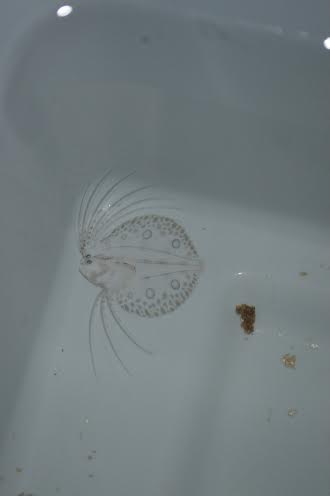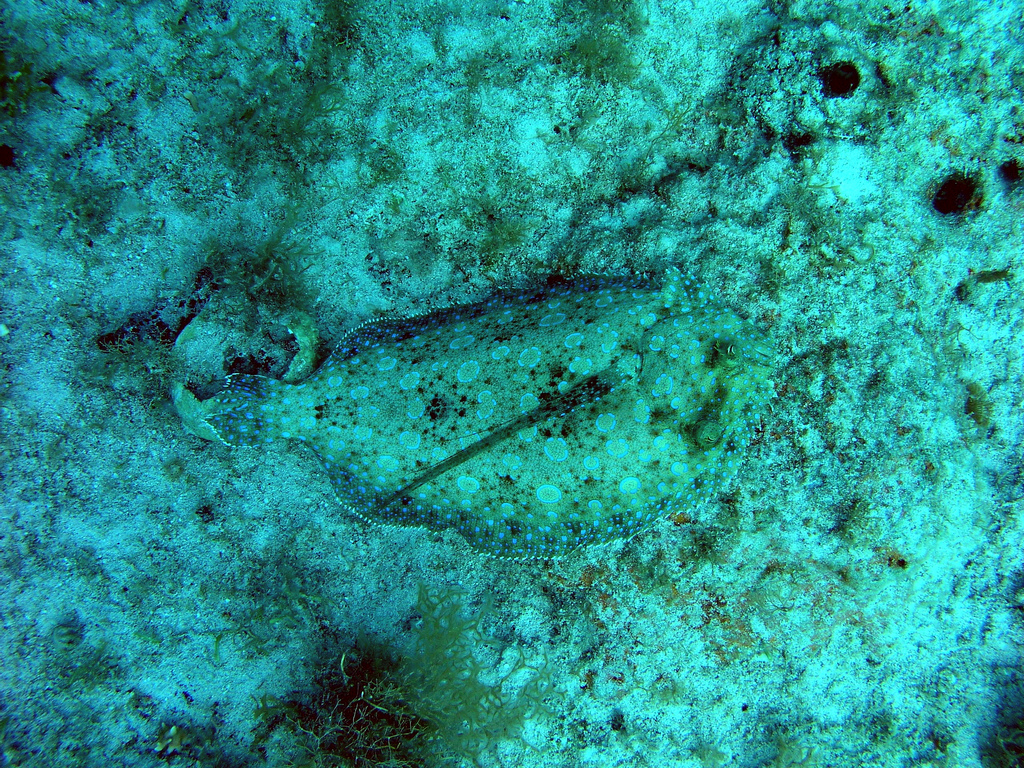Life History and Development
Bothus lunatus follows a mating system in which a male peacock flounder will mate with multiple females. He is very defensive of his territory to other males, though his female mates will choose small pieces within this area to reside in. Mating for Bothus lunatus usually takes place at dusk. The male and female will move toward one another with the ocular pectoral fin, usually used as a rudder, directed upward. The female will swim away and if the male pursues her, mating will usually commence. The couple will rise approximately 2 meters from the bottom of the ocean floor. At this 2 meter mark, a large cloud of sperm and eggs are released (Otterbein 2011). The male and the female go their separate ways, and the male verifies that the mating was successfully accomplished. He does this by checking to see if the female’s belly is still swollen with eggs. If it is still swollen, the pair will usually try again. Because mating is not always insured to be a success, this is an important step. (Konstantinou 1995; Otterbein 2011)
Peacock flounder from above. Notice how the pectoral fin is erect and how well the fish blends into the substrate.
Because the female produces eggs in large groups, like many other fish species, such as the Bighead carp, Pacific herring, and Pumpkinseed sunfish, researchers are lead to believe there is little involvement from the parents after mating and there is a low chance of survival for each individual larva. The timing and process of the mating is believed to take place in order to insure that the large number of young are widely dispersed, the number of predators are low during mating, and any predators around may be confused. (Otterbein 2011)
Bothus lunatus is observed in three developmental
stages; egg, larvae, and adult. The juvenile state in between larvae
and adult is drawn out as the individual makes the morphological
changes to reach adulthood an d sexual maturity. The B. lunatus
larvae (shown here) do not look much like their parents. The
characteristic shape of a flounder, very flat and circular, is not
present. Instead, they flatten over time until they reach adulthood.
They do not yet have the
characteristic blue pigments of their adult counterparts, making
them nearly transparent. By being nearly impossible to see, their
chance of survival is greatly increased. Another obvious distinction
is the symmetrical eyes on both sides of the larvae, features that
will become asymmetrical and on one side of the fish in adulthood.
This drastic transition is made possible by a slit that is formed
when the dorsal fin disconnects from the cranium. (Evseenko 2008,
Otterbein 2011) To take a closer look at what these features do,
explore our form and function page.
d sexual maturity. The B. lunatus
larvae (shown here) do not look much like their parents. The
characteristic shape of a flounder, very flat and circular, is not
present. Instead, they flatten over time until they reach adulthood.
They do not yet have the
characteristic blue pigments of their adult counterparts, making
them nearly transparent. By being nearly impossible to see, their
chance of survival is greatly increased. Another obvious distinction
is the symmetrical eyes on both sides of the larvae, features that
will become asymmetrical and on one side of the fish in adulthood.
This drastic transition is made possible by a slit that is formed
when the dorsal fin disconnects from the cranium. (Evseenko 2008,
Otterbein 2011) To take a closer look at what these features do,
explore our form and function page.
A metamorphosis less obvious to the naked eye is that of the swimming bladder and the intestinal loop. At the larval stage, the swimming bladder is present to help the small organism maintain the desired buoyancy, but the mature peacock flounder has no need to float any higher than the bottom of the ocean floor, so the bladder disappears as the organism matures. The intestinal loop is very large in the larvae to accommodate its diet, mostly algae. But the adult fish feeds on small crustaceans and small fish, so the large loop required to process the plant matter shortens. The teeth that allow the fish to widen their diet do not develop until the organism has nearly reached adulthood. (Evseenko 2008; Otterbein 2011)
To continue learning about the peacock flounder, go to our page on Interactions.
